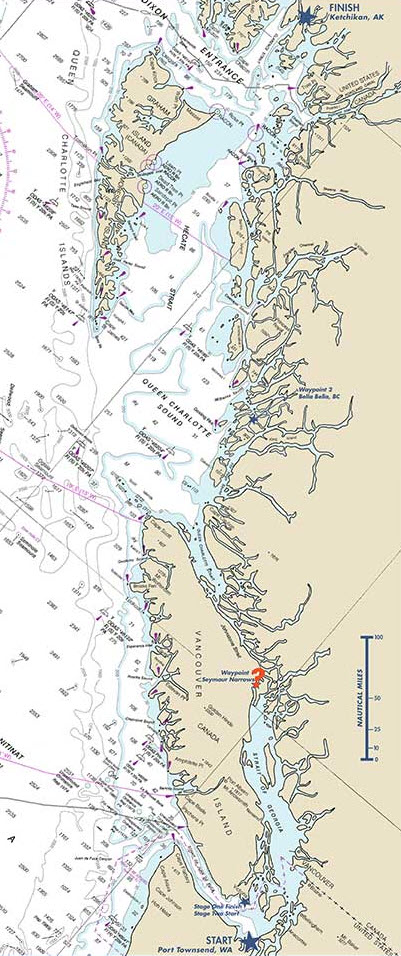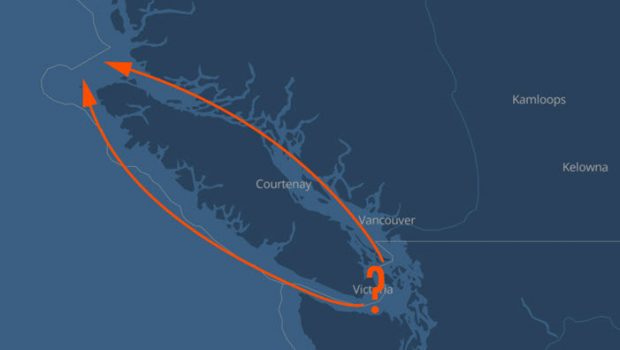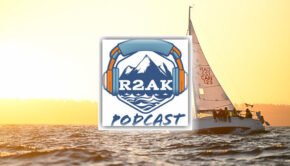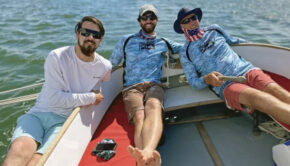R2AK: Routing around Vancouver Island
Published on June 15th, 2022
After the race was cancelled in 2020 and 2021, the 6th edition of the 750 mile Race to Alaska (R2AK) began June 13 with a 40-mile “proving stage” from Port Townsend, WA to Victoria, BC. For those that survive, they start the remaining 710 miles on June 16 to Ketchikan, AK.
Jonathan McKee, Matt Pistay, and Alyosha Strum-Palerm led their Riptide 44 monohull Team Pure and Wild to line honors in Victoria (click here for their report), with 25 of 34 entrants completing the stage in conditions McKee described as “simply too rough for any non-sailing boat, and pretty marginal for everyone.”
Here’s an update from Jim Meyers on June 15, 2022:
The Proving Ground stage of the 2022 Race to Alaska is behind us. Thankfully. Now the real fun starts.
For most, the stage two start means pedaling, rowing (or whatever) out of Victoria Harbour (eh), banging a right and heading up the stunning and bear-filled Inside Passage. However, for a few brave, ocean-hardened and crazy-in-a-good-way teams, they’ll be considering a first for the R2AK—a sanctioned west side/outside passage of Vancouver Island.
In ideal conditions the outside passage adds about 30 more miles and a boatload of risk, but it can also put teams on a conveyor belt of wind, giving them a lead over the inside teams measured in days. But maybe not.
After chatting with a number of teams over the last few days, here’s my best shot; a quick boiling down of the calculus that they’re all running through in their heads as they ponder which way to turn.
————
Consideration #1: Do you have the (right) stuff
To be even considered for the Westside route, you need to pass under the Eye of Sauron that is the Race to Alaska’s vetting team. To meet their scrutiny, you need to be sailing an ocean-worthy vessel with an experienced crew and, as Race Boss Daniel Evans explains for required gear, “We essentially followed the SERs (Sailing Equipment Requirements) from the International Offshore Racing Organization and US Sailing and had to modify a few things around engines.”
Consideration #2: The Winds
“Even veterans of the Van Isle 360 [a race around Vancouver Island] really think it’s debatable about which way to go,” says Evans. “And if you’re headed north, either the way out to the ocean or the ocean itself is not going to be optimal.
“But if you can get a fair breeze, those boats can really stretch their legs. They’ll have to do almost nothing but point it in the direction they need to go and keep watch. There are really no obstructions in their way and they can really book.”
But without that wind, or with a storm, your advantage evaporates or could become your worst nightmare. Stranger still would be a total reversal of wind, giving the teams on the inside a paradoxical advantage.
Evans adds, “Just a week or so ago there was a steady 17 knots blowing all the way through Johnston Strait and it was dead calm on the west side…anything is possible.”
Consideration #3: The Wood and the Traffic
The inside is notoriously full of logs and marine traffic. This year, thanks to an extremely wet spring, flooding coastal rivers, pulled record numbers of giant trees off their banks and spat them out into the salt.
The big ones are large enough to show up on radar, while the most dangerous ones, partially sunken “’deadheads’, bob up and down vertically, ready to punch a hole in any boat unfortunate enough not to see them.
Contrary to sailor lore, they do not disappear at night. They’re just invisible, making navigation in the dark a serious hazard. All of that will slow you down. One clear point for heading west.
Consideration #4: The Safety
On the inside, at least until the two routes converge on the north end of Victoria Island, you are rarely far from a port, and shoreline is everywhere. Conversely, on the west side, you are on your own for roughly 400 miles, with west side boats likely traveling 30-40 miles offshore to avoid nearshore hazards.
And just in case you thought your EPIRB was going to provide you some sort of solace way out there, in the skippers meeting in Victoria, the Canadian Coast Guard officer that briefed the teams reminded them, “If you’re heading out to the ocean, let me be clear, we have no offshore boats available on the west coast.”
Ponder that commitment for a second. Self-sufficiency in even the worst situations is essential as help could be days away.
————
Of course, it goes without saying that within each of the considerations above (aside from being approved to go), there is endless minutiae that would fill many evenings with conversation between sailors, each with valid points and decisions based exclusively on each boat and team’s unique attributes. Mix that in with the fickleness of a forecast and the nuanced interpretations thereof, and you’re back to the reality that it’s simply a gamble.
It could be argued that it boils down to those that are gunning for a win versus those that are looking for a more conservative adventure, but if I’ve learned anything about sailing over the last few days, it’s that universal truths are rarely universal. Maybe that’s what makes sailing so great.
Race details – Tracker – Facebook – Instagram
 Race to Alaska, now in its 6th year, follows the same general rules which launched this madness in 2015. No motor, no support, through wild frontier, navigating by sail or peddle/paddle (but at some point both) the 750 cold water miles from Port Townsend, Washington to Ketchikan, Alaska.
Race to Alaska, now in its 6th year, follows the same general rules which launched this madness in 2015. No motor, no support, through wild frontier, navigating by sail or peddle/paddle (but at some point both) the 750 cold water miles from Port Townsend, Washington to Ketchikan, Alaska.
To save people from themselves, and possibly fulfill event insurance coverage requirements, the distance is divided into two stages. Anyone that completes the 40-mile crossing from Port Townsend to Victoria, BC can pass Go and proceed. Those that fail Stage 1 go to R2AK Jail. Their race is done. Here is the 2022 plan:
Stage 1 Race start: June 13 – Port Townsend, Washington
Stage 2 Race start: June 16 – Victoria, BC
There is $10,000 if you finish first, a set of steak knives if you’re second. Cathartic elation if you can simply complete the course. R2AK is a self-supported race with no supply drops and no safety net. Any boat without an engine can enter.
In 2019, there were 48 starters for Stage 1 and 37 finishers. Of those finishers, 35 took on Stage 2 of which 10 were tagged as DNF. There were no races in 2020 and 2021 due to the pandemic.
Source: R2AK







 We’ll keep your information safe.
We’ll keep your information safe.